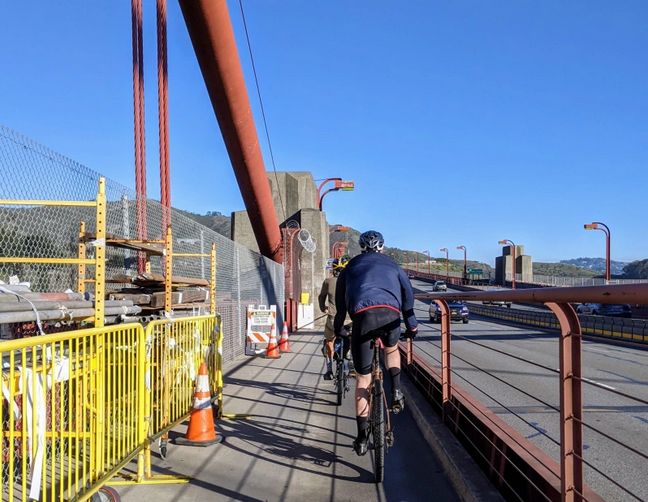A cyclist is five times more likely to crash traversing the Golden Gate Bridge as a motorist, and 21 times more likely to be injured. The high number of bike wrecks speaks to the need to make solid improvements to the windy, narrow, overcrowded, side-path shared by tourists on bike and on foot, as well as experienced local cyclists, according to Warren Wells with the Marin County Bicycle Coalition, who breaks down the statistics and analyzes plans to improve the bridge on the Marin County Bicycle Coalition's website.
Another key takeaway calculated by Wells from MCBC data and a Golden Gate Bridge District study on bicycle safety: there were 19 times as many solo bicycle collisions as there were bicycle-pedestrian collisions. As previously reported, the new fence slats next to the path amplify gusts, knocking cyclists over. "The fence slats are a new problem, but the bridge has been unsafe to ride on for a long time," Wells told Streetsblog, adding that a lack of specific data has historically made it hard to decide on corrective actions.
MCBC is urging cyclists to participate in an outreach program, recently launched by the Bridge District, to get feedback and more information to figure out how to reduce crashes.
Nevertheless, the District's study, released last year, includes some specific improvements, such as: "install additional high visibility wind warning signage along the west sidewalk to raise awareness" and "implement a Standard Operating Procedure to shift bicycle traffic to the east sidewalk during hazardous wind conditions."
The MCBC, meanwhile, also puts partial blame on Bridge District maintenance crews that use the path as a storage area, as seen in the lead image. From the MCBC's review of the study:
While the bridge’s west sidewalk is reserved by bicyclists during the weekend and weekday afternoons, during other times it serves as the staging area for maintenance staff. As such, substantial amount of construction materials are stored against the railing, further narrowing the sidewalk’s width and offering less room to maneuver. We are surprised to see that the study does not make any recommendations to increase clearances for two-way bike traffic going past construction material.
Streetsblog would add that crews would never regularly store materials in a motor-vehicle lane on the bridge, certainly not without significant traffic diversions and guidance. So why is a bike path seen as a suitable place to dump stuff?
In the Bridge District's study, engineers also suggest putting up additional speed-limit signs for cyclists. The MCBC supports the idea generally but calls out the process. "No attempt is made to disaggregate crashes by location and either cause or severity, something that limits the applicability of the recommendations. Are there locations where bike/bike crashes happen a lot? Do all severe crashes happen in one place, or are they evenly distributed across the span? These details would give us more confidence that the treatments were made to address the causes."
Indeed, the Bridge District doesn't even know if speed was a factor in the vast majority of cases (see chart below from the study):
MCBC also found lots in the study (and its suggestions) that it likes. For example:
For years, MCBC has been asking for the Bridge District to implement variable message signage to tell riders which side of the bridge they should use. While regular users eventually learn the byzantine rules about which sidewalk is open to bikes at what times, first-time or visiting riders often find themselves on the wrong side. Additionally, during high-wind events, to protect riders from the now-much-windier west sidewalk, the District will shift riders to the east side. Message boards will be placed at each approach to the bridge to inform riders which side they should use, saving people frustrating backtracking.
MCBC is asking riders of the Golden Gate Bridge to check out all their recommendations, review the District's study, participate in the outreach program, and take the Golden Gate Bridge District poll. The District is hosting aVirtual Open House, through October 10th. There will be a live Zoom Town Hall on Wednesday, October 6th at 12 noon (register here).






